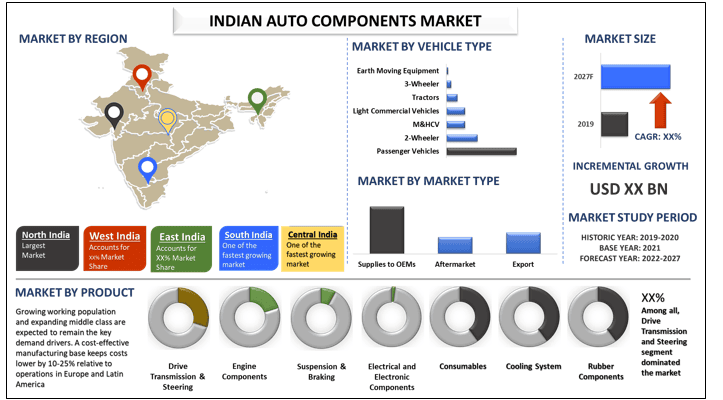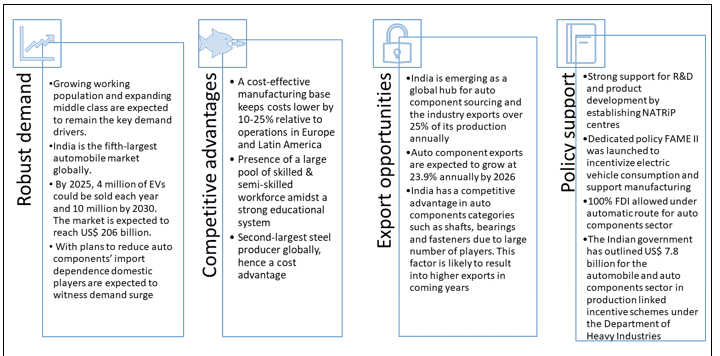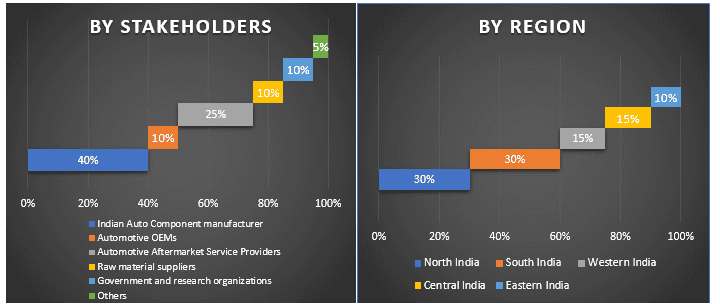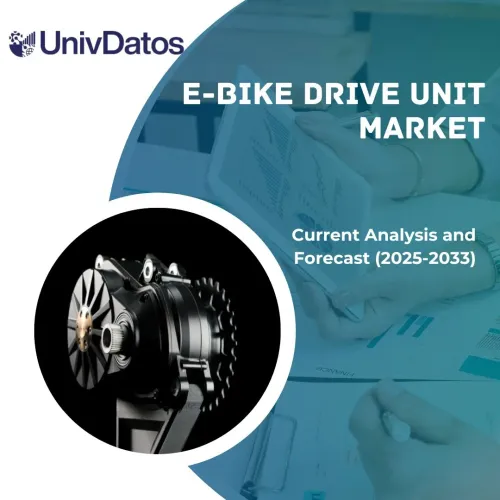- Accueil
- À propos de nous
- Industrie
- Services
- Lecture
- Contactez-nous
Marché indien des composants automobiles : Analyse actuelle et prévisions (2021-2027)
Accent mis sur les produits (transmission et direction, composants moteur, suspension et freinage, composants électriques et électroniques, consommables, système de refroidissement, composants en caoutchouc) ; type de véhicule (véhicules de tourisme, deux-roues, M&HCV, véhicules utilitaires légers, tracteurs, trois-roues, engins de terrassement) ; type de marché (fournitures aux équipementiers, marché secondaire, exportation) ; et régions

Le marché indien des composants automobiles devrait afficher un TCAC d'environ 20,3 % sur la période de prévision (2021-2027). Le marché a connu un léger déclin en 2020, en raison de la pandémie de Covid-19. L'industrie automobile indienne est l'un des plus grands employeurs avec un écosystème de plus de 50 fabricants et auxiliaires de soutien dans différentes catégories de véhicules. L'exercice 2020 a été une année difficile pour l'industrie en raison de la pandémie de Covid-19, mais l'industrie devrait connaître une reprise de croissance après 2021. Le secteur indien des composants automobiles a généré un chiffre d'affaires de 39 milliards de dollars américains en 2016 et a atteint 57 milliards de dollars américains en 2019. En 2020, le secteur a connu une baisse des ventes de près de 11,7 % pour atteindre 49,3 milliards de dollars américains en 2020. Le secteur des composants automobiles comprend les fournitures aux équipementiers nationaux, au marché secondaire et à l'exportation. Les exportations indiennes de composants automobiles ont augmenté à un TCAC de 7,6 % entre les exercices 2016 et 2020, en termes de valeur, le marché est passé de 10,83 milliards de dollars américains au cours de l'exercice 2016 à 14,5 milliards de dollars américains au cours de l'exercice 2020.
L'avantage de l'Inde dans l'industrie des composants automobiles
En raison de la pandémie actuelle et de la restriction du commerce international, les exportations de composants automobiles depuis l'Inde ont diminué de 23,6 % pour atteindre 5,2 milliards de dollars américains au premier semestre 2020-21, contre 7,4 milliards de dollars américains au premier semestre 2019-20. Les exportations de composants automobiles devraient croître de 23,9 % par an jusqu'en 2026. L'Europe a représenté 31 % de la part totale des composants automobiles exportés au cours de l'exercice 2021 (avril-décembre), suivie par l'Amérique du Nord (30 %) et l'Asie (29 %). Au cours de l'exercice 2020, les exportations de composants automobiles ont diminué de -4,6 % pour atteindre 14,5 milliards de dollars américains, contre 15,2 milliards de dollars américains au cours de l'exercice 2019.
DEMANDER UN EXEMPLE DE PDF GRATUIT
Aperçus présentés dans le rapport
« Parmi les produits, le segment Transmission et direction a dominé le marché en 2020 »
Basé sur le produit, le marché indien des composants automobiles est segmenté en Transmission et direction, Composants de moteur, Suspension et freinage, Composants électriques et électroniques, Consommables, Système de refroidissement, Composants en caoutchouc. En 2020, le segment Transmission et direction a dominé le marché, représentant plus d'un cinquième du marché. Les composants de moteur et les composants électriques et électroniques ont été les autres principaux segments générateurs de revenus en 2020.
« Parmi les types de véhicules, les véhicules de tourisme ont dominé le marché en 2020. »
Basé sur le type de véhicule, le marché indien des composants automobiles est divisé en véhicules de tourisme, véhicules à 2 roues, véhicules utilitaires moyens et lourds, véhicules utilitaires légers, tracteurs, véhicules à 3 roues, équipements de terrassement. Actuellement, les véhicules de tourisme dominent le marché avec plus de 45 % de part, suivis par les véhicules à 2 roues et les véhicules utilitaires moyens et lourds.
« Parmi les types de marché, le segment des fournitures aux équipementiers devrait connaître une croissance importante »
Basé sur le type de marché, le marché est divisé en fournitures aux équipementiers, marché secondaire, exportation. En 2020, les composants automobiles ont été principalement tirés par la demande accrue des équipementiers automobiles. Les ventes de composants automobiles sur le marché secondaire ont représenté plus de 20 % de part en 2020. TVS Group a acquis une participation de 90 % dans Universal Components UK Ltd pour 19,2 millions de dollars américains dans le cadre de ses plans d'expansion.
« L'Inde du Nord représente le plus grand marché. »
Pour une meilleure compréhension de la demande de composants automobiles en Inde, le marché est analysé pour les principales régions indiennes, notamment l'Inde (Inde du Nord, Inde du Sud, Inde de l'Est, Inde de l'Ouest, Inde centrale). L'Inde du Nord est considérée comme l'un des plus grands marchés pour les véhicules en Inde, offrant une opportunité de croissance majeure pour les fabricants de composants automobiles. Les marchés nationaux et d'exportation sont presque similaires en termes de part potentielle par différents types de produits. Les composants de moteur et d'échappement ainsi que les pièces de carrosserie et de structure devraient représenter près de 50 % des ventes potentielles nationales ainsi que des exportations en 2020. Parmi les principaux acteurs opérant sur le marché indien des composants automobiles, citons Minda Industries Ltd., Craftsman Automation et Rolex Rings Ltd., WABCO India Ltd., Endurance Technologies Ltd., Bosch Ltd., Varroc Engineering Ltd., Sundaram Clayton Ltd., Motherson Sumi Systems Limited (MSSL), Bharat Forge, Toyota Kirloskar Motors, etc.
Raisons d'acheter ce rapport :
- L'étude comprend une analyse de la taille et des prévisions du marché validée par des experts clés authentifiés de l'industrie
- Le rapport présente un aperçu rapide des performances globales de l'industrie en un coup d'œil
- Le rapport couvre une analyse approfondie des principaux pairs de l'industrie, en mettant l'accent sur les principaux aspects financiers de l'entreprise, le portefeuille de produits, les stratégies d'expansion et les développements récents
- Examen détaillé des moteurs, des contraintes, des principales tendances et des opportunités qui prévalent dans l'industrie
- L'étude couvre de manière exhaustive le marché à travers différents segments
- Analyse approfondie au niveau régional de l'industrie
Options de personnalisation :
Le marché indien des composants automobiles peut être personnalisé davantage en fonction des besoins ou de tout autre segment de marché. En outre, UMI comprend que vous pouvez avoir vos propres besoins commerciaux, n'hésitez donc pas à nous contacter pour obtenir un rapport qui correspond parfaitement à vos besoins.
Table des matières
L'analyse du marché historique, l'estimation du marché actuel et la prévision de l'avenir du marché indien des composants automobiles ont été les trois principales étapes entreprises pour créer et analyser la demande et les ventes de composants automobiles dans les principales régions indiennes. Des recherches secondaires exhaustives ont été menées pour collecter les chiffres historiques du marché et estimer la taille actuelle du marché. Deuxièmement, pour valider ces informations, de nombreuses conclusions et hypothèses ont été prises en considération. De plus, des entretiens primaires exhaustifs ont été menés avec des experts de l'industrie à travers la chaîne de valeur de l'industrie. Après l'hypothèse et la validation des chiffres du marché par le biais d'entretiens primaires, nous avons employé une approche ascendante pour prévoir la taille complète du marché. Par la suite, des méthodes de répartition du marché et de triangulation des données ont été adoptées pour estimer et analyser la taille du marché des segments et sous-segments auxquels l'industrie appartient. La méthodologie détaillée est expliquée ci-dessous.
Analyse de la taille du marché historique
Étape 1 : Étude approfondie des sources secondaires :
Une étude secondaire détaillée a été menée pour obtenir la taille historique du marché des composants automobiles indiens à travers des sources internes à l'entreprise telles que le rapport annuel et les états financiers, les présentations de performance, les communiqués de presse, etc., et des sources externes, notamment les revues, les actualités et articles, publications gouvernementales, publications des concurrents, rapports sectoriels, base de données tierce et autres publications crédibles.
Étape 2 : Segmentation du marché :
Après avoir obtenu la taille historique du marché des composants automobiles indiens, nous avons mené une analyse secondaire détaillée pour recueillir des informations historiques sur le marché et les parts de différents segments et sous-segments pour les principales régions. Les principaux segments inclus dans le rapport sont le produit, le type de véhicule et le type de marché. Des analyses plus approfondies au niveau régional ont été menées pour évaluer la demande globale de composants automobiles dans le contexte indien.
Étape 3 : Analyse des facteurs :
Après avoir acquis la taille historique du marché des différents segments et sous-segments, nous avons mené une analyse des facteurs détaillée pour estimer la taille actuelle du marché. De plus, nous avons effectué une analyse des facteurs à l'aide de variables dépendantes et indépendantes telles que la croissance de la propriété de véhicules dans le pays, les progrès technologiques dans le secteur automobile, etc. Les tendances historiques et leur impact d'une année sur l'autre sur la taille et la part du marché ont été analysés. Le scénario de l'offre et de la demande a également été étudié en profondeur.
Estimation et prévision de la taille actuelle du marché
Détermination de la taille actuelle du marché : Sur la base des informations exploitables tirées des 3 étapes ci-dessus, nous sommes arrivés à la taille actuelle du marché, aux principaux acteurs du marché et aux parts de marché des segments et des entreprises. Tous les pourcentages de répartition et les ventilations du marché requis ont été déterminés à l'aide de l'approche secondaire mentionnée ci-dessus et ont été vérifiés par des entretiens primaires.
Estimation et prévision : Pour l'estimation et la prévision du marché, des pondérations ont été attribuées à différents facteurs, notamment les moteurs et les tendances, les contraintes et les opportunités disponibles pour les parties prenantes. Après avoir analysé ces facteurs, des techniques de prévision pertinentes, c'est-à-dire une approche ascendante, ont été appliquées pour arriver aux prévisions du marché jusqu'en 2027 pour différents segments et sous-segments dans les principales régions de l'Inde. La méthodologie de recherche adoptée pour estimer la taille du marché comprend :
- La taille du marché de l'industrie, en termes de valeur (US$) et la demande de composants automobiles dans les principales régions indiennes
- Tous les pourcentages de parts, les répartitions et les ventilations des segments et sous-segments du marché
- Les principaux acteurs du marché indien des composants automobiles en termes de produits proposés. De plus, les stratégies de croissance adoptées par ces acteurs pour rivaliser sur le marché en croissance rapide.
Validation de la taille et de la part du marché
Recherche primaire : Des entretiens approfondis ont été menés avec les principaux leaders d'opinion (Key Opinion Leaders - KOLs), y compris les cadres supérieurs (CXO/VPs, chef des ventes, chef du marketing, chef des opérations et chef régional, chef de pays, etc.) dans les principaux pays. Les résultats de la recherche primaire ont ensuite été résumés et une analyse statistique a été effectuée pour prouver l'hypothèse énoncée. Les informations issues de la recherche primaire ont été consolidées avec les résultats secondaires, transformant ainsi l'information en informations exploitables.
Répartition des participants primaires dans différentes régions
Ingénierie du marché
La technique de triangulation des données a été employée pour compléter l'estimation globale du marché et pour arriver à des chiffres statistiques précis de chaque segment et sous-segment du marché indien des composants automobiles. Les données ont été divisées en plusieurs segments et sous-segments après avoir étudié divers paramètres et tendances dans les domaines des produits, du type de véhicule et du type de marché pour les principales régions indiennes.
L'objectif principal de l'étude du marché indien des composants automobiles
Les tendances actuelles et futures du marché indien des composants automobiles sont mises en évidence dans l'étude. Les investisseurs peuvent acquérir des informations stratégiques pour fonder leur discrétion en matière d'investissements à partir de l'analyse qualitative et quantitative effectuée dans l'étude. Les tendances actuelles et futures du marché détermineraient l'attractivité globale du marché au niveau régional, offrant une plateforme au participant industriel pour exploiter le marché inexploité afin de bénéficier d'un avantage de premier entrant. Les autres objectifs quantitatifs des études comprennent :
- Analyser la taille actuelle et prévisionnelle du marché indien des composants automobiles en termes de valeur (USD). De plus, analyser la taille actuelle et prévisionnelle du marché des différents segments et sous-segments de l'industrie
- Les segments de l'étude comprennent le produit, le type de véhicule, le type de marché et les régions
- Analyse définie du cadre réglementaire de l'industrie indienne des composants automobiles
- Analyser la chaîne de valeur impliquée avec la présence de divers intermédiaires, ainsi qu'analyser les comportements des clients et des concurrents liés à l'industrie
- Analyser la taille actuelle et prévisionnelle du marché indien des composants automobiles à travers le monde. Les principales régions analysées dans le rapport comprennent l'Inde (Inde du Nord, Inde du Sud, Inde de l'Est, Inde de l'Ouest, Inde centrale)
- Définir et analyser le paysage concurrentiel du secteur indien des composants automobiles et les stratégies de croissance adoptées par les acteurs du marché pour se maintenir sur le marché en croissance rapide
Analyse approfondie au niveau régional de l'industrie
Connexes Rapports
Les clients qui ont acheté cet article ont également acheté










